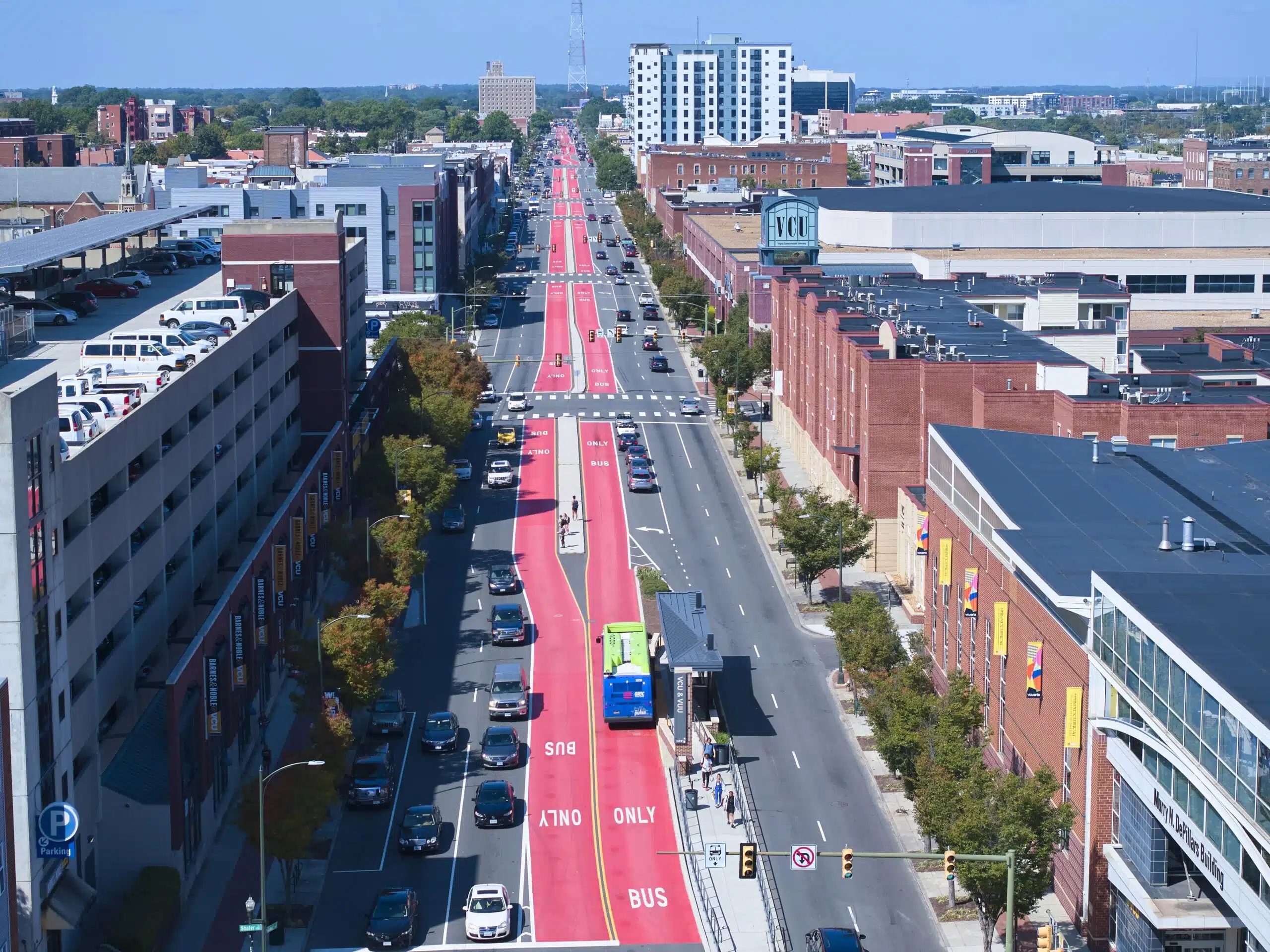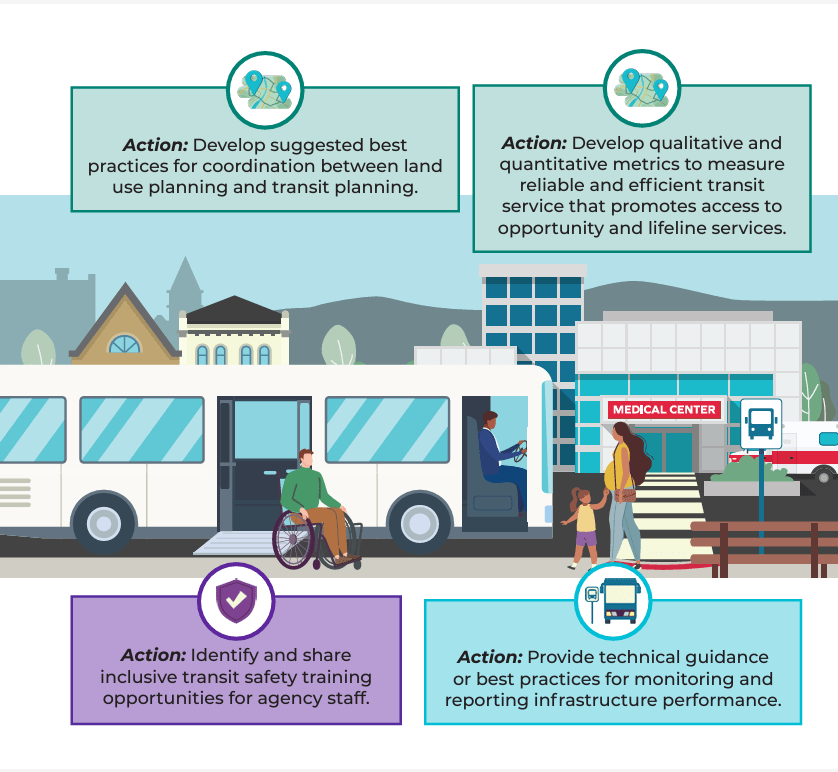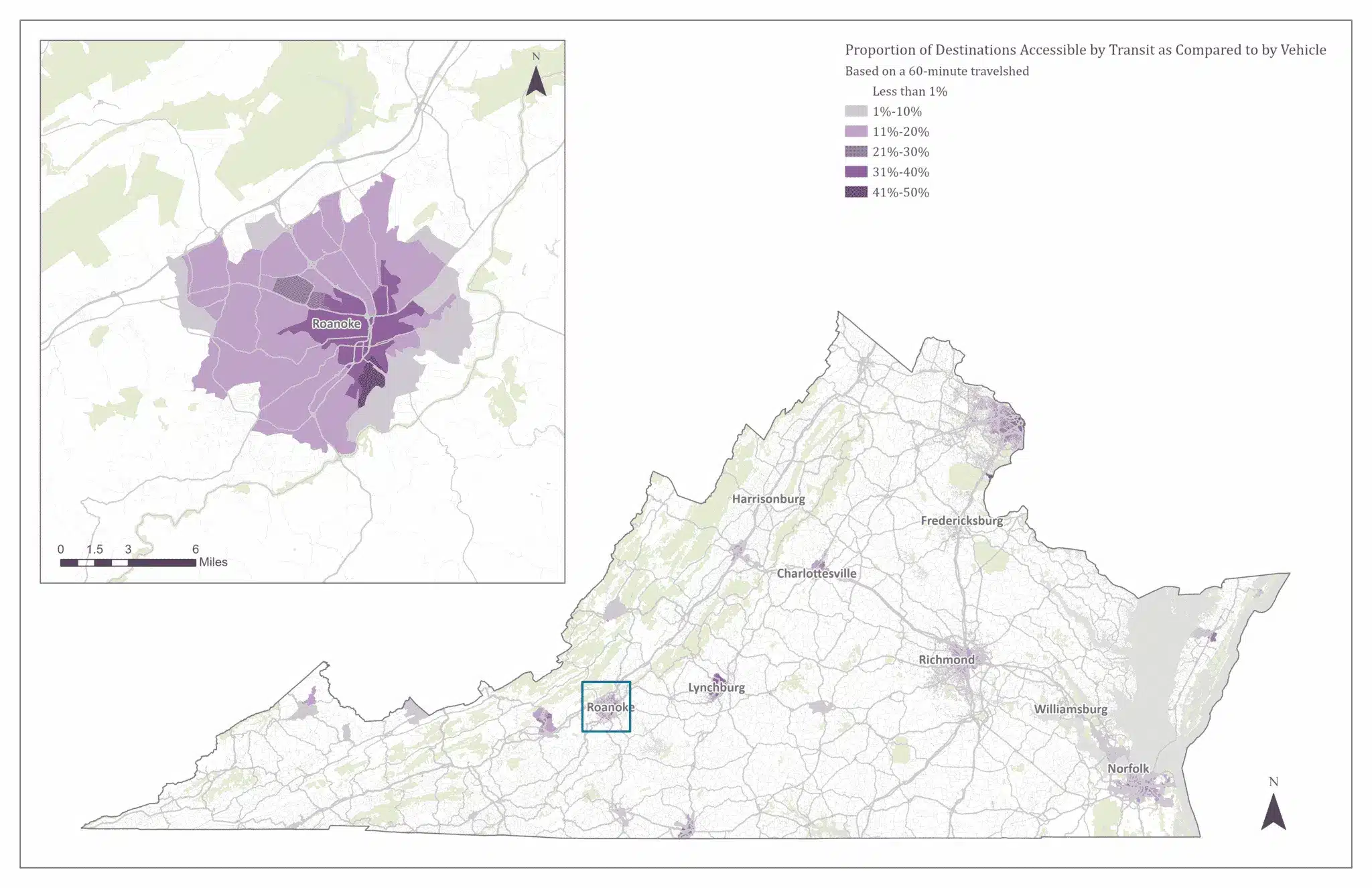- July 24, 2024
- Perspectives, Trending Topics
Seven Best Practices for Prioritizing Transit Equity

The Richmond – GRTC Pulse BRT Red Pavement project

Beth Bartz, AICP
Planner

Danielle McCray, PE
Transportation Engineer
Many transit agencies and planners are searching for ways to integrate equity into their projects and put underserved communities first in decision making. Our approaches to two transit studies—one in Virginia and one in Washington—highlight a multi-faceted approach that can help stakeholders hone in on local needs and elevate equitable representation in their own projects.
Diverse Opportunities to Elevate Transit Equity
Virginia Transit Equity and Modernization Study: The Department of Rail and Public Transportation (DRPT) set out to identify equity gaps and opportunities for transit engagement throughout the state, involving nearly 40 Virginia Commonwealth transit agencies in the study. With a focus on accessibility, infrastructure, technology, electrification, and more, the team collaborated with DRPT to gather diverse perspectives from transit agency leadership, staff, service operators, and underserved communities.
Equity Considerations for Sound Transit’s Everett Link Extension: The planned Everett Link Extension (EVLE) is more than 16 miles long and will provide at least six more light rail stations in an expanding part of the greater Seattle area. Kimley-Horn is in charge of transit design and preliminary engineering through final system engineering as well as planning, environmental phasing oversight, and public engagement management. We coordinate very closely with Sound Transit and our subconsultants for all aspects of the project—and “EVLE team” throughout this article refers to Kimley-Horn, Sound Transit, and our partners as one cohesive group. Together, we are prioritizing those who use the transit system the most and weaving equity considerations throughout the project—particularly when examining alternate locations for transit stations in historically underserved areas.
Equity in Transit Projects: Seven Best Practices
Our equity-focused priorities and processes offer guidelines to help stakeholders reimagine transit projects and boost their community impact.
1. Plan Equity from the Start
The EVLE team wove equity throughout planning by using a Racial Equity Tool (RET) that Sound Transit developed as part of their commitment to agency-wide diversity, equity, and inclusion. Described as “both a product and a process,” Sound Transit’s RET provides a streamlined avenue for project development staff to identify equity-focused goals, collect relevant data, involve diverse community voices, and make critical decisions about how people will be impacted by project updates and outcomes. The RET allows equity to rise from being a subconscious project benefit or an afterthought to being explicitly integrated from the beginning.
Similarly, the Virginia Transit Equity and Modernization Study leaders analyzed equity from a variety of angles. We developed a methodology with diverse perspectives—including representatives from transit agencies throughout the state such as RVA Rapid Transit, GRTC Transit System, and Bay Transit (who each participated in a 2023 WTS panel alongside Kimley-Horn on this project).
2. Set a Scope for Equity
Part of integrating equity into projects involves scope setting—determining what aspects of the project need attention and what communities deserve priority in impact considerations. The Virginia Transit Equity and Modernization study considered equity in six key project areas:
Accessibility: Is the transit system available and usable for the people who need it most?
Adequacy of infrastructure: Can the current buses, stops, stations, and other infrastructure support the needs of the community?
Emerging technologies: How can new technology make transit more efficient, accessible, and environmentally friendly?
Electrification: Are agencies interested in transit electrification, and what would be the best path to creating an electric, zero-emission bus fleet?
Safety: How can transit systems prioritize passenger safety, both in terms of on-the-bus security and safety in different traffic and roadway conditions?
Engagement and governance: How can transit systems ensure widespread agency engagement in setting priorities and standards, making changes, and procuring funding?
This identification of focus areas allowed the team to develop technical working groups that could devote their attention to these topics. Team segmentation ensured that all pre-identified transit equity priorities would receive importance in the project’s big picture.
For Sound Transit’s EVLE scope setting, the team considered ways to not just reduce harm, but also to elevate the transit-dependent, low-income, and underrepresented populations in the area to achieve an outcome that worked for everyone. While the RET tool provided general guidance, the team had to strategize how to specifically apply it to a capital project. This equity-informed scope setting enabled the team to build engagement with communities and relevant data collection into the project plan.
3. Prepare the Team and Branding
Planners must visualize the need for equity and develop wording to explain the “why” behind their decisions. For the Virginia Transit Equity and Modernization Study, this meant a series of discussions led by subconsultant Powerful Pathways. Discussions were held separately with the project team and subconsultants, the DRPT leadership team, and the Virginia transit agency CEOs to educate everyone on unconscious bias in design and planning, the history of transportation disparities and community impacts, and equity in decision making.
The team also recognized the value in honing a brand that could tell a cohesive story throughout the project and effectively engage the public and other stakeholders. A graphic designer created templates, branding guidelines, and a website that the client and the project team leveraged throughout the process. Graphic dioramas further illustrated topic areas and increased understanding of the situations the study wanted to focus on.
4. Identify Community Data to Collect
The EVLE team recognized the value of collecting both quantitative and qualitative community data early in the project. The quantitative data the team collected included information on the proximity of station locations to minority populations and the number of people with disabilities within a given walkshed. Collecting qualitative data included asking people about the following:
- Potential for acquisitions to impact affordable housing
- Culturally-specific community facilities
- Important resources for low-income residents
- Possible changes to traffic operations
The EVLE team set clear and measurable data collection parameters to reflect equity considerations. For instance, the team defined low-income as 200% of the federal poverty level and specified that this population included those within a 10-minute walk of other stations based on existing residential uses.
The Virginia Transit Equity and Modernization Study team similarly delineated specific data collection goals into three categories:
- Travel choice: What kinds of transportation do people choose? What considerations do they use to select how to travel?
- Travel reach: What areas are people able to access with the transportation options available to them? How do limitations on travel constrain or enable people to receive community resources?
- Travel opportunity: What is the quality of the passenger experience? What options do regular transit riders have and how do they access bus stops? How do transit services and ride experiences provide passengers with the ability to live vibrant, connected lives?
These equity measures allowed the team to effectively analyze more than 650 bus stops throughout the state and create a data-driven, holistic picture of Virginia’s transit systems.
5. Leverage Technology Tools
The Virginia Transit Equity and Modernization team leveraged technology in thoughtful ways to collect feedback, identify gaps, and present information to key stakeholders. By using a data-driven planning tool developed by Kimley-Horn, the team measured travel reach and destination opportunity metrics for potential riders around the Commonwealth. After initial evaluations, the team assigned a score to each region based on the accessible community resources and other destinations within an hour travel radius or less.
In addition to surveying accessible transit across regions, planners also created a visualization that contrasted how travel by personal vehicle compared to transit ridership in terms of opportunity access. The use of data-driven visualizations allowed the Kimley-Horn team and DRPT to connect the dots on equity across Virginia, locate underserved areas that had limited connectivity to community resources, and prioritize projects in those areas.
6. Implement a Multi-faceted Community Engagement Strategy
Creating solutions that authentically represent the community of transit users was a focal point of the Virginia Transit Equity and Modernization Study. The Kimley-Horn team used a multi-faceted approach to collect feedback—including focus groups, a public forum, a survey, and a story-sharing campaign. The rider focus groups helped capture the rich stories and lived experiences of passengers, and the inclusive group makeup of riders, non-riders, users with disabilities, and people from various geographic regions supplemented and enhanced the data analysis.
The team also maintained regular communication on project goals, presenting to government boards and soliciting community engagement through social media, a study website, and an e-newsletter. Altogether, DRPT had more than 3,500 interactions with stakeholders and community members, including participation from all 39 transit agencies across Virginia. This widespread engagement effort captured narratives from diverse people throughout the Commonwealth and enriched the project’s capacity to identify equity gaps and prioritize changes.
Similarly, the EVLE team relied on multiple modes of engagement to collect community data. Relationships with non-profits and other community groups helped the team better understand the needs of the area and establish trust. Additionally, the team created an inclusive Community Advisory Group that helped bring in diverse voices to speak on decision-making and held neighborhood pop-up events in historically underserved areas.
The EVLE team also set up workshops facilitated by equity subconsultants and invited underrepresented populations to the workshops to gather their input. To ensure that project communication was accessible to participants, the EVLE team provided communication in a variety of languages. This approach created multiple ways for community members to contribute to project considerations and potential outcomes.
7. Ensure Equity Considerations are Integrated
After collecting community and stakeholder data, the EVLE team evaluated options through a newly-honed equity lens. In addition, we integrated considerations, including the following:
- Land use plan consistency
- Population and job changes
- Cost estimates
- Multimodal transportation connections
- The adaptation of natural and built environments over time
For the EVLE project, using the RET allowed the project team to spotlight the advantages and disadvantages of alternative station locations specifically in terms of equity and community needs. The team created presentations highlighting these discoveries for key community groups, further building on the relationships they had honed throughout the engagement process. As the project continues, the EVLE team plans to reinforce equity by investigating additional station locations and choosing preferred alternatives. Additionally, the group plans to bring community members back in for workshops to further specify goals and implement equity after the initial research period.
As part of their process, the DRPT team identified areas across the state to potentially adopt emerging technology, integrate bus stops and sidewalks more consistently, increase perceived and actual safety for transit riders, improve basic transit infrastructure, and more. The team and their collaborators have since moved forward with a three-pronged strategy to map out the basic needs we discovered in different regions, create an official action plan, and kick off the plan with next steps for implementation.
Integrating equity into transit plans does not happen accidentally—it involves intentional community engagement, data collection, and prioritization from the beginning of a project. As stakeholders learn more about how to weave equity into transit plans in a way that makes an impact, we and our partners are here to help implement these seven best practices into future projects.
About the Authors

Beth Bartz, AICP
Beth is a senior project manager in Kimley-Horn’s environmental and transportation practices and is also heavily involved in our public engagement and communications efforts. Over her three-decade career, she has helped public sector clients achieve broad community and agency agreements on challenging transportation and land use planning projects. She has also worked on many significant highway and river crossing projects, facilitating development of project alternatives within the context of NEPA, state environmental regulations, and community goals. Beth is known for her effective public engagement approaches, combining educational and strategic approaches to facilitate meaningful input and durable decisions.

Danielle McCray, PE
Danielle has more than a decade of multimodal transportation planning, transportation operations, and corridor planning experience. She has worked on various projects across the state of Virginia, including multimodal studies and implementation plans on corridor and area-wide projects. Additionally, she has completed county-wide bus route analyses, documenting performance measures, costs, and funding strategies for Transit Development Plan updates, and she operated as a project manager for the Virginia DRPT’s Transit Equity and Modernization Study.


